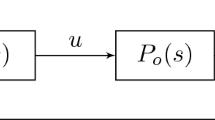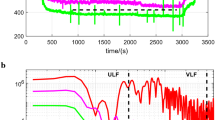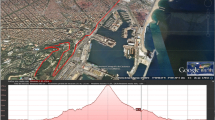Abstract
This study investigated the relationships between walking speed and heart rate (HR) variability (HRV) in eleven subjects during a 24-h race. It was hypothesized that the nycthemeral rhythm on HR is preserved during the race. RR intervals and walking speed were measured. Fast Fourier transform was applied to samples of 1,024 successive RR intervals collected every hour from a HR monitor. Walking speed was averaged every hour and decreased (first lap: 8.8 ± 0.3 vs. last lap: 7.3 ± 0.8 km h−1, P < 0.001) with HR also decreasing (max at 19:00 h: 143 ± 9 vs. min at 7:00 h: 117 ± 14 beats min−1, P < 0.001) following a third order polynomial shape. HRV power spectral components followed distribution patterns similar to the mean RR during the race with a minimum in the early evening (19:00–20:00 h) and a maximum in the morning (5:00–8:00 h). Thus, as for mean RR, spectral components over time are also fitted to a third order polynomial regression. LF/HF ratio increased linearly (min = 0.5 ± 0.3, max = 2.8 ± 5.3, P = 0.02). Although mean HF peak did not decrease significantly over time, it was positively correlated with walking speed. In conclusion, this study showed that despite a constant decrease in walking speed, HR circadian rhythm is preserved during a continuous 24-h walking race. The short-term HRV components remain linked to HR whereas the LF/HF ratio increases linearly until the end of the race whatever HR is.



Similar content being viewed by others
References
Baher EK, Fogg LF, Eastman CI (1999) Intermittent bright light and exercise to entrain human circadian rhythms to night work. Am J Physiol (Regulatory Integrative Comp Physiol) 46:R1598–1604
Bernasconi P, Kohl J (1993) Analysis of co-ordination between breathing and exercise rhythms in man. J Physiol 471:693–706
Blain G, Meste O, Bermon S (2005) Influences of breathing patterns on respiratory sinus arrhythmia during exercise. Am J Physiol (Heart Circ Physiol) 288:H887–H895
Bonsignore MR, Morici G, Abate P, Romano S, Bonsignore G (1998) Ventilation and entrainment of breathing during cycling and running in triathletes. Med Sci Sports Exerc 30:239–245
Callard D, Davenne D, Lagarde D, Meney I, Gentil C, Van Hoecke J (2001) Nycthemeral variations in core temperature and heart rate: continuous cycling exercise versus continuous rest. Int J Sports Med 22:553–557
Cohen CJ (1980) Human circadian rhythms in heart rate response to a maximal exercise stress. Ergonomics 23:591–595
Cohen CJ, Muehl GE (1977) Human circadian rhythms in resting and exercise pulse rates. Ergonomics 20:475–479
Cottin F, Papelier Y, Escourrou P (1999) Effects of exercise load and breathing frequency on heart rate and blood pressure variability during dynamic exercise. Int J Sports Med 20:232–238
Cottin F, Médigue C, Leprêtre PM, Papelier Y, Koralsztein JP, Billat VL (2004) Heart rate variability and dynamic cardio-respiratory interactions during exercise. Med Sci Sports Exerc 36:594–600
Cottin F, Médigue C, Lopes P, Petit E, Papelier Y, Billat VL (2005) Effect of exercise intensity and repetition on heart rate variability during training in elite trotting horse. Int J Sports Med 26:859–867
Danel T, Libersa C, Touitou Y (2001) The effect of alcohol consumption on the circadian control of human core body temperature is time dependent. Am J Physiol Regul Integr Comp Physiol 281:R52–R55
Deschenes MR, Kraemer WJ, Bush JA, Doughty TA, Kim D, Mullen KM, Ramsey K (1998) Biorhythmic influences on functional capacity of human muscle and physiological responses. Med Sci Sports Exerc 30:1399–1407
Eysmann SB, Gervino E, Vatner DE, Katz SE, Decker L, Douglas PS (1996) Prolonged exercise alters beta-adrenergic responsiveness in healthy sedentary humans. J Appl Physiol 80:616–622
Harris FJ (1978) On the use of windows for harmonic analysis with the discrete Fourier transform. Proc IEEE 66:51–83
Kraüchi K, Wirz-Justice A (1994) Circadian rhythm of heat production, heart rate, and skin and core temperature under unmasking conditions in men. Am J Physiol 267:R819–R829
Macor F, Fagard R, Amery A (1996) Power spectral analysis of RR interval and blood pressure short-term variability at rest and during dynamic exercise: comparison between cyclists and controls. Int J Sports Med 17:175–181
Pagani M, Lombardi F, Guzzetti S, Rimoldi O, Furlan R, Pizzinelli P, Sandrone G, Malfatto G, Dell’orto S, Piccaluga E, Turiel M, Baselli G, Cerutti S, Malliani A (1986) Power spectral analysis of heart rate and arterial pressure variabilities as a marker of sympatho-vagal interaction in man and conscious dog. Circ Res 59:178–193
Schepens B, Willems PA, Cavagna GA, Heglund NC (2001) Mechanical power and efficiency in running children. Pflugers Arch 442:107–116
Task force of the European Society of Cardiology, the North American Society of Pacing, Electrophysiology (1996) Heart rate variability. Standards of measurement, physiological interpretation, and clinical use. Circulation 93:1043–1065
Tulppo MP, Mäkikallio TH, Takala TES, Seppänen T, Huikuri HV (1996) Quantitative beat-to-beat analysis of heart rate dynamics during exercise. Am J Physiol (Heart Circ Physiol) 271:H244–H252
Wahlberg I, Astrand I (1973) Physical work capacity during the day and night. Work Environ Health 10:65–68
Williams KR (1985) Biomechanics of running. Exerc Sport Sci Rev 13:389–441
Youngstedt SD, Kripke DF, Elliott JA (2002) Circadian phase-delaying effects of bright light alone and combined with exercise in humans. Am J Physiol Regul Integr Comp Physiol 282:R259–R266
Acknowledgments
This study was supported by Polar France Electro and the Genopole of Evry. The authors thank the pleasant organization team of the 200 km of Bourges 2004 who have kindly welcomed us and allowed this investigation to be carried out.
Author information
Authors and Affiliations
Corresponding author
Rights and permissions
About this article
Cite this article
Cottin, F., Slawinski, J., Lopes, P. et al. Effect of a 24-h continuous walking race on cardiac autonomic control. Eur J Appl Physiol 99, 245–250 (2007). https://doi.org/10.1007/s00421-006-0341-3
Accepted:
Published:
Issue Date:
DOI: https://doi.org/10.1007/s00421-006-0341-3




